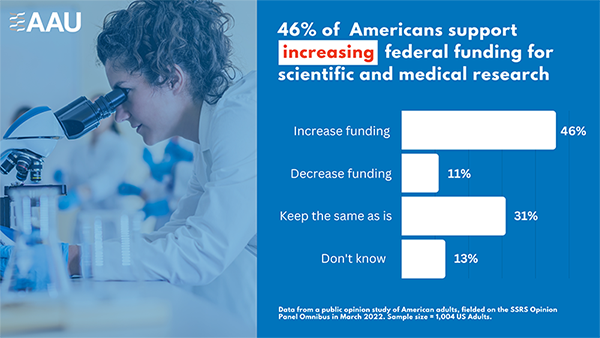 House Passes Stopgap Funding Bill, Averts Partial Government Shutdown
House Passes Stopgap Funding Bill, Averts Partial Government Shutdown
The House voted 230-201 today to pass a stopgap funding bill (H.R. 6833) and avert a partial government shutdown. The bill will extend current government funding through December 16. The Senate voted 72-25 yesterday to pass the measure; it now goes to President Biden’s desk for his signature.
The bill includes $12 billion in funding for emergency military and economic relief for Ukraine; $4.5 billion for domestic disaster relief, including for wildfires in New Mexico; and $1 billion in home heating assistance. The bill also extends Food and Drug Administration user fees for five years.
 House Reauthorizes Programs to Spur Small Business Technological Innovation
House Reauthorizes Programs to Spur Small Business Technological Innovation
Yesterday, the House voted 415-9 to pass a bill (S. 4900) reauthorizing the Small Business Administration’s Small Business Innovation Research and Small Business Technology Transfer programs for an additional three years.
The SBIR/STTR programs provide funds to startups and small businesses to stimulate technological research and innovation and to bring new technologies to the market. The programs have provided seed money to companies such as iRobot, famous for the Roomba robot vacuum cleaner, Symantec, and Qualcomm. The bill passed the Senate last week and now goes to President Biden’s desk for his signature. The programs were set to expire at the end of September.
 NASEM Releases Report on Protecting U.S. Technological Advantage
NASEM Releases Report on Protecting U.S. Technological Advantage
The National Academies of Sciences, Engineering, and Medicine released a new report yesterday outlining what the federal government can do to protect the United States’ global leadership in science and technology, especially the scientific openness that forms the basis of research and innovation. University of Pittsburgh Chancellor Patrick D. Gallagher co-chaired the project committee that wrote the report.
Historically, the federal government has sought to protect its technological advantage by placing restrictions on certain areas of technology, particularly those related to the military. Recently, there has been talk of expanding controls to other areas, including biotechnology, quantum computing, and artificial intelligence. The report argues, however, that expanding such restrictions is unlikely to work because emerging technologies frequently span multiple disciplines and rely on multinational teams of researchers.
The report suggests that the government should instead “strive to maximize the amount of work that can be appropriately performed in an open research environment” and develop a “risk-management approach” to critical technologies. The report offers several steps that the federal government can take to manage these risks while ensuring that there are limited restrictions on fundamental research and that the United States continues to develop and attract top scientific talent. Doing anything less, the report notes, would slow the pace of development and threaten the nation’s global competitive advantage. The report is now available on the NASEM website.
 Energy Sciences Coalition Urges At Least $8.1 Billion for DOE Office of Science in FY23
Energy Sciences Coalition Urges At Least $8.1 Billion for DOE Office of Science in FY23
The Energy Sciences Coalition, of which AAU is a member, sent a letter urging the leaders of the House and Senate appropriations subcommittees on energy and water to appropriate at least $8.1 billion for the Department of Energy Office of Science in FY23. As the letter explains, the DOE Office of Science is the “nation’s primary sponsor of physical sciences research” and “plays a vital role in the American scientific ecosystem.”
The coalition’s letter notes that the increase in appropriations is needed to ensure that the agency can continue to support “groundbreaking scientific discoveries,” construct and operate its “world-class scientific facilities,” and help advance “energy technologies needed for the nation to meet net-zero carbon emissions economy wide.” The funding levels would also help the agency expand existing workforce and education programs to “prepare and diversify the next generation of American scientific and engineering talent.”
The letter also expresses interest in working with the subcommittees to advance “new DOE Office of Science research initiatives, science and technology centers, and infrastructure investments” authorized in the CHIPS and Science Act.
News of Interest
The Charlotte Observer: UNC Chancellor: Topping the Charts Is Great, But College Rankings Don’t Tell the Whole Story – U.S. News & World Report ranked the University of North Carolina at Chapel Hill the fifth-best public university in the nation. UNC Chancellor Kevin Guskiewicz says that, while the recognition is welcome, the rankings do not capture “all of the fantastically diverse goals of a place like Carolina.” Guskiewicz notes that the rankings overemphasize reputation and do not account for the “distinct missions” of different universities, including public service or affordability and access. He hopes that the people of North Carolina are proud that UNC both retains “a top spot in major college rankings” and “remains committed to its founding ideals, to a set of values that can’t be captured in a number.”
The Hill: LGBTQ+ Students with Campus Mental Health Services Report Fewer Suicide Attempts, Still Face Barriers to Care – A new study from the Trevor Project shows that, in the last year, one out of three LGBTQ+ college students seriously considered suicide. Those who could access mental health services through their schools, however, were 84% less likely to attempt suicide than those whose schools did not offer access. The study also found that a large majority of LGBTQ+ students (86%) find it difficult to access care despite their schools offering it.
Austin American-Statesman: University of Texas Reports Record Overall Enrollment, Four-Year Graduation Rates – The University of Texas at Austin reported a combined undergraduate and graduate fall enrollment of nearly 52,400 – more than any other year. The university said that the increase in enrollment is driven largely by improved four-year and six-year graduation rates. UT also enrolled 13,872 historically underrepresented students – “one of the largest totals of any state flagship university” or AAU member.
USA Today: Fact Check: Harvard’s Endowment Is Taxed, Has Limitations on Spending – Despite assertions to the contrary, Harvard University’s endowment is not a tax-free hedge fund that returns money to investors. Instead, it is taxed and is a “combination of charitable donations, gifts and investment income” that is used to support the “university’s teaching, financial aid, research, and more.”
Inside Higher Ed: Attack on Vanderbilt Campus Has Ripple Effects – Vanderbilt University Medical Center’s Transgender Health Clinic is the latest clinic to come under attack for offering gender-affirming care. The threats and harassment as well as the growth in legislative attempts across the country to prevent access to gender-affirming care for trans youth is intimidating healthcare professionals and having a “regressive impact on expanding access to this kind of care, however effective it’s proven to be.”
The Hill: How the CHIPS and Science Act Can Revolutionize US Tech Diversity – In an opinion piece, Invent Together Executive Director Holly Fechner commends the new CHIPS and Science Act for addressing “the barriers commonly faced by those historically excluded in science and technology by expanding access to education and skill development.” Invent Together is an alliance of stakeholders, including AAU, that seeks to “close diversity gaps in inventing and patenting.” Fechner writes that robust implementation of the act “will help ensure that all Americans have the opportunity to participate fully in the innovation ecosystem.”
Higher Ed Dive: Here’s What Happened When 3 Colleges, Including the University of Pennsylvania, Went Test Optional – More than 1,800 four-year institutions have now made test scores optional for admissions. At the University of Pennsylvania, test-optional policies led to a 34% increase in applications; the school also “saw a bump in applications from first-generation and international students, as well as from students of color.” Similarly, at the University of California, Los Angeles, test-free policies led to a 38% jump in the number of applications for admissions; applications from underrepresented students grew 48%.
Featured Research

$25 Million MU Grant Will Help Farmers Adopt Climate-Smart Practices
The U.S. Department of Agriculture has awarded the University of Missouri $25 million to help Missouri farmers adopt climate-smart practices. The five-year project is aimed at working with farmers to improve crop and livestock resiliency in the face of growing threats from climate change, including droughts and excessive rainfall.

3D Printing Drones Work Like Bees to Build and Repair Structures While Flying
Researchers from the University of Pennsylvania and Imperial College London have developed drones that can 3-D print materials while in flight and can help repair buildings and other structures. The drones could be used to build or repair “hard-to-access, dangerous, or challenging height location areas, like tall buildings and bridges.”
Stat of the Week

Public Support for Federal Research Spending
Federal funding for research has led to major scientific, technological, and medical breakthroughs, including the COVID-19 vaccine, the internet, and GPS technology. In recent years, however, federal funding for research has declined substantially. As President Biden reminded everyone during the signing of the CHIPS and Science Act, decades ago, the United States used to invest 2% of its GDP in research and development; today we invest less than 1% even as countries like China increase their investments. Americans understand this is a problem and support increasing federal funding for research. A study conducted by AAU in March 2022 shows that 46% of the American public supports increasing federal funding for scientific and medical research.
 ICYMI: Barbara’s Blog: The American Public Supports Bolstering U.S. Competitiveness Through Science
ICYMI: Barbara’s Blog: The American Public Supports Bolstering U.S. Competitiveness Through Science